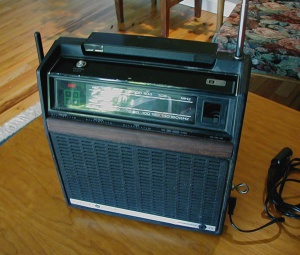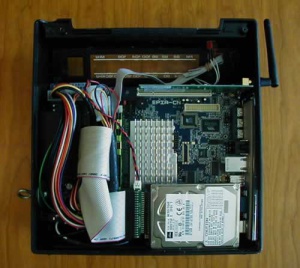8track
My quest for low power systems began in my Carbon diet page and now it continues with this system. It is smaller, faster, and uses less energy than the earlier Via EPIA 800 system. I migrated from the C3 to the C7 system. Now to an Intel "Little Falls" Atom 230 board.
Origin of the name 8track. When I was riding around Corvallis one day, I saw a pile of free stuff in front of someone's house. Right on top was a GE portable AM/FM 8 track player. I could not pass it up. I immediately envisioned putting a computer in the case and that is exactly what happened.
I realize now that I could probably have sold it for $10 on Ebay! Well, I have gotten more than $10 worth of entertainment out of it so far.
I used 8track as the unofficial [Solar CREEK kiosk] at DaVinci Days 2006. It ran off solar power all day playing a video and allowing access to the Solar CREEK Web site.
Alas it is no longer in the 8 Track player but I stuck with the name.
Hardware specs
"8track" was originally a complete computer system based on a Via CN10000 Mini-ITX board built inside the 8 track player case. The overpriced Morex automotive power supply died when it was less than a year old. Rather than throw more money at Morex, I replaced the case with a commercially built slim case.
8track currently has
- Via CN10000 C7 mainboard
- 1GB RAM
- 80 GB 7200 rpm Seagate SATA drive
- Casetronic case
With the Morex automotive power supply the power options included using either an old HP Omnibook 800 laptop power supply or a 12 volt gel cell. At the Solar CREEK booth at DaVinci Days, I ran it on a solar panel and a 120 vac inverter.
Originally I used the 2.5" drive because the Morex did not support the power requirements of a 3.5" drive on its 12V output. A Toshiba 4200 rpm 30 GB drive was IDE (PATA) and plugged into a 44-40 pin adapter. The Seagate SATA drive is a huge improvement, it's much faster.
At DaVinci days, I used an Acer 15" display and a PS/2 keyboard and mouse. The monitor ran off the inverter, too. I plugged in stereo speakers and connected to the Solar CREEK web site via a wireless link.
The HP power supply puts out about 35 watts and it had no trouble running this machine in the above configuration. I measured output of the supply and found it took about 10 watts to run.
I need to take measurements on the new configuration.
Main board
I bought the CN10000EG fanless C7 board from Logic Supply.
Mini-review: The CN10000 board works quite well as a server, but it does not have enough juice to run the Java Netbeans IDE and the video drivers are not up to snuff for Ubuntu Hardy Heron.
Maybe the video chip itself WOULD work but the drivers don't support the high end Gnome features. I am not sure. I wish that Via did more work to support their products or at least open them up. They dandy hardware like graphics and media decoder and encryption chips on the board then do not provide up-to-date Linux drivers for them.
I got my EPIA C3 800 Mhz mainboard from Logic Supply, too. It has since died. I abused it, static probably got it.
Some specs:
VIA CN700 north bridge VIA VT8237R south bridge LAN: VIA VT6103 10/100 AUDIO: VIA VT1618 8 channel AC'97 codec
File:CN10000.pdf PDF manual
C7 kernels
When I first got the C7 board I had to build a custom kernel because it was not supported by default on Ubuntu. Currently I use the standard Ubuntu kernels but here are my old notes on kernel building for the C7.
http://www.howtoforge.com/kernel_compilation_ubuntu_p2?s=2e4e7db1d3b0009a48132ba132e72f9e&
make-kpkg clean fakeroot make-kpkg --initrd build kernel_image kernel_headers modules
This builds the packages up one layer, you have to go there and install them.
cd .. sudo dpkg -i packagename ..and so on
Software
24 Aug 2007 Via C7 (The old board, now in Bellman)
I have most all the multimedia features working smoothly now. HOWEVER, the system still LOCKS UP sometimes when running Realplayer.
Annoying but not bad enough to work on it!
It also occasionally locks up when running VMWare machines! Again, I don't do this often enough for it to be worth working on, I am hoping the newer kernels which now support the C7 processor will fix things eventually.
Ethernet
With the initial release of Ubuntu 8.04, the ethernet driver for the Little Falls board was broken. Ubuntu soon released 8.04.1 to fix it -- but the onboard Realtek ethernet interface remained so unreliable that I stuck a 3com NIC in there for a few weeks while waiting for smarter people to figure it out.
Without some extra help Linux thinks the chip is an R8169 and loads that driveer but that is wrong. With 8.10 I did more poking around and discovered that I could compile and install the 8101 driver from the Realtek site (release 1.011) and things seem to be okay now.
Symptom: Ethernet appears to be working but no data will flow across the link. Reboot and it works. Reboot and it doesn't...
Driver Fix
- Download and install r8101 driver from Realtek download site. ("LINUX driver for kernel 2.6.X and 2.4.X")
- Unpack it in /usr/src and do
make make install depmod -a echo blacklist r8169 >> /etc/modprobe.d/blacklist-network update-initramfs -u
You have to repeat this process if you upgrade your kernel. I got the idea to do this from here that tell how to compile and install the driver. Ignore the part about patching it. The latest Realtek driver already has the patches installed.
Drivers for RTL8101E and R8110S
Since I wanted to try out gigabit networking with my Intel Atom motherboard, and the builtin interface only does 100BT, I added a Dlink 1Gb card.
All was well until I decided to use 8track as a router.
If you add a 1GB card that is based on the Realtek chipset RTL8110S then the two interfaces get in a fight. The kernel prefers to use the r8169 driver over the r8101 driver and since r8169 has a signature for the built-in RTL8101E interface, it tries to use it for the motherboard interface which then fails 1/2 the time. We are back where we started.
The solution is to to download and install the r8169 driver from RealTek
I am guessing that both the RTL8101E and RTL8110S chipsets are happier running with drivers written by their creator anyway.
If you do this then when you type 'make install' you overwrite the stock driver and you don't want to do the blacklist thing listed above.
Since the Realtek driver does not include the RTL8101 signature in its r8169 driver, the kernel finds and loads the correct driver for each card.
Nice theory Brian, but it's still finding the r8169 module first!
Next I am trying a tip from another web page,
- Edit /etc/initramfs-tools/modules to add the drivers in order
- update-initramfs -u -k all
- reboot
BIOS upgrade
8.10 seemed to have significant problems, until I realized the system BIOS was at rev level 67 and the current version is 103. Since updating BIOS things seem to be running much better.
The upgrade files can be downloaded from Intel and put on a floppy. Remember floppies? I might still have a drive somewhere in my junk pile.
I downloaded a copy of PCDOS 7, copied it to a thumbdrive.
dd if=pcdos7.IMA of=/dev/sdb1
This gives me a thumbdrive with no space for the BIOS files (and no way to expand it as it's FAT12 format), but PCDOS knows about CDROM's, so I put IFLASH.EXE and the BIOS file onto a CD and ran them from there.
USB problem
In 8.0.4.1 these messages filled log files. This problem seems to have gone away in 8.10.
26.100735 hub 3-0:1.0: over-current change on port 2[ 26.204644 hub 5-0:1.0: over-current change on port 5 26.308536 hub 5-0:1.0: over-current change on port 6 26.412452 hub 3-0:1.0: over-current change on port 1 26.516351 hub 3-0:1.0: over-current change on port 2 26.620257 hub 5-0:1.0: over-current change on port 5 26.724160 hub 5-0:1.0: over-current change on port 6 26.828059 hub 3-0:1.0: over-current change on port 1
Random number generator
32.407090 intel_rng: Firmware space is locked read-only. If you can't or 32.407096 intel_rng: don't want to disable this in firmware setup, and if 32.407100 intel_rng: you are certain that your system has a functional 32.407103 intel_rng: RNG, try using the 'no_fwh_detect' option.
Packages of note
Some Ubuntu "upgrade" happened and now Firefox 3 crashes every 5 minutes. I am using Seamonkey but have been thinking about going to Kubuntu so I am looking at what packages I want to reload... I have a ton installed now but most can get dumped.
I used digiKam for photo transfer and archiving. Hugin makes photo sets into panoramas. Vlc plays my videos.
I have been experimenting with QT so I have all the QT packages installed, including the Python support. For Python I have Komodo 5.0.3 I also have the wxPython stuff loaded.
QT is actually the best reason to go to Kubuntu since it's built on QT and the QT development system is built on Kubuntu.
I used eagle to view and edit schematics and circuit boards.
I use VMware Workstation. Save and restore /usr/lib/vmware/licenses
I backed up everything (about 10 GB) on the internal system volume to an external hard drive with this command
mkdir /media/disk-4/bellman-backup-7-Feb-09 tar c --exclude=proc --exclude=var --exclude=home --exclude=dev --exclude=media --exclude=sys --exclude=tmp -f - * | (cd /media/disk-4/bellman-backup-7-Feb-09; tar xpf -)
Where is it now?
8track is now the machine we use here at home 95% of the time. It is so power efficient and quiet that I use it in preference to either the laptop or the old desktop system for most of my work.
Pictures

A wood strip is fitted to cover over empty slots left when I removed the various controls (volume, tone and so on.) It fits the style of cases of this vintage though it's real hardwood not contact paper!

Here you can see the interior layout.
There is enough room at the top of the case to accomodate an LCD display. The Trendnet Wifi card fit in easily once I removed its card slot adapter.
I used a router* to enlarge the 8-track slot to fit the mainboard back panel. The styrene plastic is very easy and clean to work with a carbide bit. I probably won't get cancer for many more years.
The large metal ring on the left is an eye bolt to allow me to lock down the case when I leave it unattended in public places.
- Def router: a motor with a spinning cutter attached, not a network device.